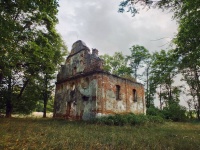- Home
- →
- Attractions
- →
- Church of Svyatoduhovsky in Yazviny
Church of Svyatoduhovsky in Yazviny
Yazviny Church of the Holy Spirit is an outstanding example of Baroque architecture from the mid-18th century, located in the village of Yazviny. Although the church is currently in a semi-ruined state, it continues to attract the attention of travelers, historians, architecture researchers, and pilgrims. Once a place of spiritual unity, the building has become a symbolic reminder of a bygone era and reflects the rich religious and cultural heritage of the region. It is one of those places that offer unforgettable impressions and deep emotions, especially when it becomes part of a well-organized tour. More and more people are choosing excursions across Belarus that include visits to such unique, though lesser-known, sites. The Yazviny church is often featured in tour routes through the western part of the country and can be seen as part of a one-day excursion from Minsk or as an element of a thematic tour of Catholic shrines in Belarus.
History of Construction
The history of the Church of the Holy Spirit in Yazviny dates back to the mid-18th century. The temple was built with the funds of local landowners and parishioners as a sign of faith, resilience, and the cultural influence of the Catholic Church in this region. At that time, the church served not only a spiritual function but was also the center of community life in the village. People from all around would gather here to participate in services, baptisms, weddings, and other church festivities. In both architectural and spiritual terms, it became a symbol of its era.
The fate of the church changed with the arrival of Soviet power. In the 1930s, the church was closed, religious services ceased, and the building itself was plundered. For many years, it was either misused or left abandoned. As a result of decades of neglect, the church fell into a state of disrepair. However, interest in its history has not waned, and today its ruins are seen as an important historical witness to the past — a memory of the spiritual grandeur that once characterized the village of Yazviny.
Architecture and Spiritual Life
The church is a rectangular brick structure built in the Late Baroque style. Its main architectural feature is an expressive decorative pediment that gives the church a sense of solemnity and grandeur, even in its current, ruined condition. The interior once housed an altar, decorative elements, carved wooden sculptures, and painted walls. These interiors have been lost, but the building still impresses with its scale and architectural expressiveness.
Despite the absence of active religious life, the site remains a symbol of spirituality. Many tourists, pilgrims, and local residents visit to connect with history, experience the atmosphere of a bygone time, and honor the memory of their ancestors. The Yazviny church often becomes a place for silent prayer, photography, and historical research, as well as the focus of attention from restorers and local historians who dream of preserving at least part of its heritage for future generations.
Excursions with a Visit to the Church
Today, the Church of the Holy Spirit in Yazviny is included in various tourist routes across the Hrodna and Brest regions. These tours are especially popular with those seeking unusual places off the beaten path. Thanks to convenient logistics and the availability of experienced guides, it is possible to book an excursion with a visit to the church. Particularly in demand are excursions from Minsk, which allow you to explore several fascinating architectural monuments in a single day, including the Yazviny church.
On the website ekskursii.by, you can choose excursions across Belarus dedicated to sacred architecture, abandoned shrines, or religious tourism routes. You can book an excursion with a visit to the church online by selecting a convenient date. This is a great opportunity to expand your horizons, learn more about the spiritual history of Belarus, and discover places where time seems to have stood still.

